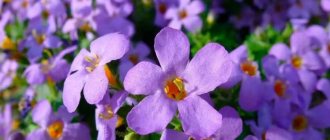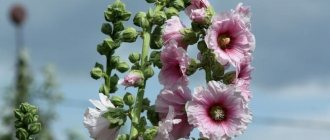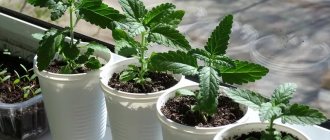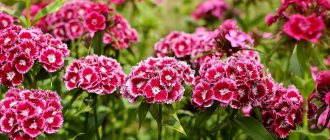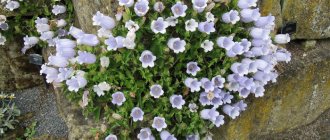Antirrinum, or snapdragon, is a subshrub plant with beautiful spike-shaped inflorescences. The flower is valued for its appearance and relative ease of care.
Dear readers! For you, we have created communities on social networks in which useful articles and interesting ideas are published several times a day! Subscribe and receive useful content in a convenient format!
The plant is used to decorate home areas and public gardens. The most effective is the seedling method of growing snapdragons.
How to prepare planting material for sowing
Before planting grains in the ground for growing Antirrinum seedlings, they are prepared. The preparation process usually includes 2 procedures: disinfection and stimulation.
You can disinfect the seeds by soaking them for half an hour in a pink solution of potassium permanganate or a solution of hydrogen peroxide (a teaspoon per glass of water).
Stimulation includes soaking planting material in a growth stimulator (Epin, hydrogen peroxide, Gumi, aloe juice, etc.).
Unlike other flowers, Antirrinum grains do not require long soaking. It is enough to keep the seeds in gauze soaked in a nutrient composition for just 2 hours.
When to sow snapdragon seedlings in 2022 according to the lunar calendar?
In our country, the calendar of agricultural work has long been associated with the lunar calendar. There are favorable days for planting, and there are unlucky days, when it is better not to carry out any work with plants, including growing seedlings.
Lucky days are those when the moon is waxing, and unlucky days are full and new moons. The days of the waning moon are considered neutral.
ON A NOTE. There is also a superstition that work cannot be carried out on those days of the month when the moon passes through the constellation Aquarius.
Favorable days for sowing snapdragons in 2022 depending on the month
Below is the time when it is best to plant snapdragons for growing seedlings in 2022 according to the lunar calendar:
- In January
— 6, 7, 16, 17, 21, 22, 23, 24, 25, 26 - In February
– 3, 4, 12, 13, 14, 17, 18, 19, 20, 21, 22, 23 - In March
– 11, 12, 13, 16, 17, 19, 20, 21, 22, 23, 24, 29, 30, 31 - In April
– 8, 9, 13, 14, 15, 17, 18, 26, 27 - In May
– 5, 6, 7, 10, 11, 12, 13, 14, 15, 23, 24
When you shouldn't plant flowers, bad days
Agronomists agree that it is impossible to carry out serious agrotechnical work, which includes, for example, sowing seeds, on the days of full and new moons, so you should not plant snapdragons on these days.
These days are considered unlucky for growing, and gardeners traditionally try not to disturb the plants.
- In January
— 1, 2, 3, 18
- In February
– 1, 2, 16 - In March
– 1, 2, 3, 18 - In April
– 1, 2, 16, 29, 30 - In May
– 16, 29, 30, 31
ON A NOTE. Some summer residents also do not work the day before and the day after these natural events.
Medicinal properties. Use in folk medicine
Easterners used a decoction of the plant as an antidote. Mixing snapdragon decoction with lily oil, they applied this mixture to the face. This remedy was considered rejuvenating.
Antirrinum terry (Twinnie Appleblossom)
Snapdragon is not only a beautifully flowering plant, but thanks to the beneficial substances included in its composition, it has acquired the status of a medicinal plant that helps with various diseases
Traditional healers used antirrinum to combat diseases of the gastrointestinal tract, eyes, intestines, and colds.
Procurement of raw materials
Field Snapdragon
- To prepare decoctions and infusions, the upper leaf plates and racemes are used. Raw materials need to be harvested during flowering.
- The collected vegetative parts of the flower are laid out in a thin layer in a dark, well-ventilated room.
- After the raw material has dried, it is placed for storage in paper bags or canvas bags.
- You can prepare healing ointments, infusions, and decoctions from snapdragons.
Traditional medicine recipes
Traditional healers have come up with a lot of effective recipes based on snapdragons:
Sore throat treatment
- In case of an inflammatory process accompanied by severe pain, gargle with a decoction of snapdragon.
- To prepare it, take 5 g of dry raw material and add 200 ml of boiled water.
- The broth should be boiled for 15 minutes, cooled, strained and gargled with it.
- The same product can be used to wash sore eyes.
- And if you take 1 tsp orally, its effect will be laxative and diuretic.
Ointment for the treatment of the prostate gland
- To prepare a healing ointment, take 2 tbsp. l. crushed dry raw materials (snapdragon flowers), place in a glass container, pour 1 tbsp. l. 70% alcohol.
- The jar needs to be covered with a lid, wrapped and placed in a warm place for 4 hours.
- Then, after the time has elapsed, unsalted melted lard (10 tbsp) is added to this mixture, which is preheated for 2.5 hours in a water bath.
- Everything is mixed and filtered. Lubricate problem areas with the finished ointment.
Tea will help prevent the liver
- Brew 40 g of herb in 1 liter of boiling water and take it several times a day.
- The tea is good for 1 day.
In addition, preparations based on medicinal plants are used to prepare healing baths and to treat boils in the form of compresses and lotions.
Contraindications for use
Antirrinum red
You should know that snapdragon is a poisonous plant. Therefore, it must be taken strictly with the permission of a doctor and not exceeding the indicated dosage.
Cannot be taken with:
- hypertension
- dyspepsia
- cardiovascular diseases
- Pregnancy and lactation are also a contraindication to taking drugs based on snapdragon.
Marigolds (Chernobrivtsy) Description, growing from seeds, planting and care, diseases (80+ Photos & Videos) + Reviews
When to plant antirrinum depending on the region?
The climatic conditions of the growing region have a decisive influence on the timing of sowing snapdragon seedlings.
- In Kuban and Crimea, grains can be planted from the first days of March;
- In the Black Earth Region, Volga region, Central Russia - in the 2-3rd decade of March;
- In the Leningrad region and Vologda region - the end of March;
- Ural, Siberia, Far East - early April.
Planting snapdragon seeds step by step
The algorithm for sowing Antirrinum seeds is simple and does not differ much from sowing other plants.
- Seed material is prepared and processed.
- Containers are being prepared. You can plant the plant in a common box (then you will need picking).
- The grains are slightly pressed into the ground. There is no need to cover it with soil afterwards.
- Next, the plantings are moistened and covered with air-tight material.
- The entire structure is placed in a warm place until shoots emerge.
How to care for snapdragon seedlings, any tricks?
From the moment the seedlings emerge, the stage of caring for seedlings at home begins. Young plants need to be provided with the conditions they need for growth and development.
The snapdragon seeds have sprouted, what to do next?
When the seedlings appear, the trays with seedlings should be moved to a cooler place with a temperature of about 17-18 degrees. For example, on a windowsill. After a few days, the plants are returned to warmth again.
Now it is necessary to create appropriate growing conditions in which the seedlings will grow until planted in the ground.
- Temperature . Ideally 23-24 degrees. There is no need to create too hot conditions, but cool conditions are not suitable either, otherwise the seedlings will develop too slowly.
- Light . Seedlings should be illuminated by the sun at least 12 hours a day. With a lack of sunlight, seedlings stretch out, become weak and painful.
- humidity should be moderate. In winter, because of the batteries, the room is dry, so you will have to increase the air humidity. But there is no need to create “tropics” either.
- Watering . It is necessary to moisten the seedlings as the soil in the trays dries out. Overfilling should not be allowed - rotting processes will begin.
- Feeding . When growing seedlings, fertilize them only 2-3 times. The first fertilizing can be done after germination. Use Agricola. The second feeding is carried out after picking. The third - 15-20 days after the pick.
ON A NOTE. Agronomists advise feeding seedlings with mineral fertilizers rather than organic matter.
How to feed snapdragon seedlings
The most effective preparations for feeding Antirrinum are complex mineral products. For example, Agricola, Gumi, Gumate, Zircon, etc.
Among folk remedies, it is best to use a solution based on ammonia.
Rules for picking snapdragons
Picking is carried out only after the appearance of 2 true leaves.
In order for the plants to better separate from the soil, you need to moisten the soil 1.5 - 2 hours before the procedure. At the same time, it is necessary to prepare new containers by first filling them with the required amount of soil.
A teaspoon, an ice cream stick or any other similar tool is used as a picking tool.
Seedlings should be separated from the ground with a lump of earth so as not to damage the root system.
After picking, the plants are watered, and after a couple of weeks they are fed with mineral fertilizer.
Diseases and pests
Antirrinum does not have excessive requirements, but problems associated with infection by pathogenic microorganisms may arise. The plant can be attacked by diseases - rust, anthracnose.
In unfavorable agrotechnical conditions (too high temperature, nitrogen overload, poor ventilation in the greenhouse, high air and soil humidity, excessive density), plants are often affected by Phyllosticia or brown spot (pathogen - Phyllosticia antirrhini). Gray-brown spots quickly cover the leaves and shoots, the plants wither and die. The fungus is successfully combated with drugs - Ditan (0.2%), Captan (0.2%).
Plant diseases caused by pathogenic microorganisms - fungi of the genera Verticillium and Fusarium - may also appear. Their occurrence is prevented by decontaminating the greenhouse, sowing boxes and soil, and treating the seeds. These diseases are difficult to control, their spread can be limited with the help of drugs - Benlat (0.2%), Topsin M (0.2%), Funaben (0.2%).
Rust appears as chocolate brown spots on the leaves where the spores spread. The disease is caused by the pathogen Puccinia anfirrhini. Control the disease with fungicides. Symptoms are characteristic greenish-yellow spots on leaves and shoots, causing the death of leaves and then of entire plants.
The development of rust is promoted by:
- tight fit,
- undisinfected soil,
- high humidity.
After observing the first signs of rust, Cincotox (0.3%), Dithane M-45 (0.2%) and Saprol (0.1%) are alternated every 7-10 days.
Sometimes the plant is affected by powdery mildew (false or true), rot. At the seedling stage, rotting of the neck may be observed - black collar (can cause large losses in the early stages of plant development). At the same time, the neck of the stem darkens and the seedlings break.
Among the pests you should beware of aphids and spider mites. To combat these pests, it is recommended to use insecticides or acaricides at intervals of 10-14 days, for example, Pirimor (0.1%).
When to plant seedlings in open ground?
Transplantation of seedlings into open ground is carried out starting from the second ten days of May in the southern regions and from the beginning of June in colder regions of the country.
ON A NOTE. Transplantation can be carried out when the temperature at night reaches at least 10 degrees.
Snapdragon loves sun, so don't plant it in the shade. The flower also prefers well-drained soil, so before planting, you can add a little sifted river sand to the soil.
Plants should be planted at a distance of at least 20 cm from each other. This way, the seedlings will not interfere with each other’s growth, but the plantings will not feel sparse.
Features of care
Growing
Such a flower is undemanding in care and only needs timely watering, weeding, fertilizing, and also needs to systematically loosen the soil surface. Watering should be done only during drought, but we must remember that this procedure cannot be carried out in the evening. After watering, it will be necessary to loosen the soil surface and perform weeding; this can be done on the same day or every other day. Experts advise tying tall varieties to a support. After the flower begins to fade, it must be removed from the bush, as it takes away the strength of the plant. In order for such a plant to bloom for a long time, it should not be allowed to set seeds; also, after the last flowers wither, you need to cut off the flower shoot. It is necessary to trim the peduncle under the flower located at the very bottom, only in this case new arrows and flowers will grow. The first time you need to feed the snapdragon is after it takes root after transplanting into open soil, and for this you use nitrophoska and organic fertilizers. The plant needs to be fed a second time during budding; in this case, a nutrient solution consisting of potassium sulfate, urea and superphosphate is used, and 1 large spoon of each substance should be taken per bucket of water.
Diseases and pests
It happens that bushes are affected by rust, and red spots appear on their surface. This plant is also susceptible to infection with blackleg, root and gray rot, and septoria. Diseased plants must be destroyed as soon as possible, then the area of soil where they grew must be treated with a fungicidal (antifungal) agent. Pests that pose a danger to snapdragons include fly larvae, scale insects, caterpillars, and butterflies that are capable of laying eggs. It should be remembered that getting rid of diseases or harmful insects is much more difficult than preventing a plant from becoming infected. For the purpose of prevention, it is necessary to follow all recommendations for the care of snapdragons, so it is necessary to promptly destroy diseased and infected specimens with harmful insects; You should not plant flowers very close to each other; it is necessary to water correctly, avoiding waterlogging of the soil; Watering should be done at the root, while ensuring that water does not fall on the surface of the leaf plates.
After flowering
The flowering of such a plant can continue until the first frost in the fall. After autumn sets in, those snapdragon bushes that are cultivated as perennials should be trimmed very short, so that the height of the shoots is about 5–8 centimeters. Then you need to mulch the area, sprinkling it with a layer of dried leaves or sawdust mixed with peat. In the case when you have an annual snapdragon, then after the flowers begin to fade, you should remove them, thereby avoiding self-seeding. After all the flowers on the arrow have withered, it needs to be trimmed as short as possible. This will prevent the seeds from ripening and scattering on the surface of the soil. After the onset of late autumn, it is necessary to dig up the soil where the flowers grew and burn the remains of the snapdragon, as harmful insects can settle on them.
Interesting Facts
- The name of the plant is translated from ancient Greek as “nose-like.”
- According to legend, the flower was given to Hercules for his victory over the Nemean lion.
- In Russia, Antirrinum is called “dogs”, in France – “cleft mouth”, in England – “biting dragon”.
- In the USA, snapdragon is one of the most popular flowers used in bouquets.
- The dried fruit capsules of Antirrinum look like human skulls.
Description of the flower with photo
Snapdragon looks like a small bush with even branches, painted with thick greenery and thin stems that are no more than 15 centimeters. Depending on the variety, the height varies up to one meter and forms pyramidal flower bushes.
The leaf blades located on top are alternate. The leaves growing from the lower part of the stem are defined as opposite. The foliage shape is elongated, lacent, the standard color is light green. Some varieties have leaves of dense green tones with pronounced reddish veins.
Snapdragon flowers have an unobtrusive aroma and are not too large in size. Forms, as well as appearance, are completely dependent on the variety. Double, ordinary, spikelet-shaped flowers. All types have a variety of color shades and are divided into many varieties.
Snapdragon in a flower garden
After flowering, they form into multi-seeded boxes, in each of which many thousands of grains capable of reproduction simultaneously ripen. The flowering period begins in the first month of summer. The ornamental plant blooms colorfully for a long time until the arrival of the first autumn frosts.
Answers to frequently asked questions
Despite the fact that growing seedlings is a traditional and long-known type of agricultural work, some questions still remain. Let's look at the most popular of them.
What soil should I buy for growing seedlings?
If you do not yet have sufficient experience in growing seedlings, then it is better not to experiment and purchase universal soil. This substrate has all the necessary properties for the healthy growth of seedlings.
Manufacturers also now offer special soil for seedlings. It will also work, although, in fact, it is not much different from the universal one.
How can you stimulate seeds for further growth?
To stimulate it, it is better to use growth biostimulants. For example, Agricola, Zircon, Gumi, etc. You can also use folk remedies: infusions based on yeast, coffee or onion peels.
REFERENCE. It is better to use purchased products. They show great efficiency. In addition, some plants do not take well to organic matter during growth.
Why don't the seeds germinate?
There are three reasons for this phenomenon:
- Poor quality seeds. You need to purchase proven seed material.
- Agrotechnical errors. Planting too deep, lack of soaking, etc.
- The deadline hasn't come yet. Some seeds germinate only 2 weeks after sowing.
Why are seeds soaked?
Soaking seeds before planting is intended to stimulate growth, soften the outer shell and disinfect.
Soaking is not a mandatory procedure, but significantly increases the germination of seeds during cultivation.
How to harden snapdragon seedlings?
To harden seedlings before planting in a flowerbed, start taking boxes of seedlings out into the open air 1-2 weeks in advance. Gradually increase the time the plants stay outside the house from 1 to 24 hours. On cloudy and stormy days, it is better to leave the seedlings at home. After the procedure, the seedlings are ready for transplanting.
What to do if snapdragon seedlings do not grow?
Seedlings do not grow solely due to errors in agricultural technology. Normalize watering, provide the required amount of sun during cultivation and the required temperature, pick and fertilize the seedlings.
Varieties for cultivation
This is a perennial plant, but due to climatic conditions, many people grow snapdragons as an annual.
Dwarf
The height of plants of these varieties is 12-20 cm. They are often used to create carpet flower beds and decorate borders.
Low
The height of such plants is 25-45 cm. These plants are usually used to decorate flower beds, containers and boxes for decorating balconies.
Medium height
Plants of this species have a height of 50-70 cm, are not prone to branching, and have a fairly compact shape, which makes them an ideal option for decorating flower beds and flower beds. They are also grown for later cutting.
High
It is these plants that are used for cutting, which is why they are called cut plants. The main advantage is that they can remain fresh for a long time - up to two weeks if you constantly add water.
The height of an adult plant is 70-90 cm, they are planted in group compositions, and mixborders are created with the help of such plants.
Gigantic
Giant plants reaching a height of 120-130 cm. Suitable as a “natural curtain” to hide ugly parts of walls and fences, and combine well with other shrubs.

